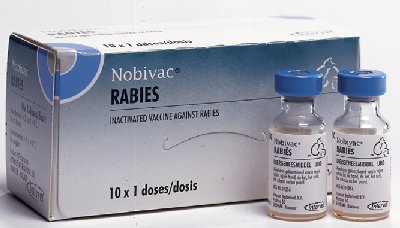Rabies
By: Jaydon Bao, Emily Pierce, and Elizabeth Bernheisel


What is the Rabies virus?
Definition: Rabies is a zootonic disease that is spread to humans from the saliva of infected animals.
The rabies virus attacks the central nervous system causing severely distressing neurological symptoms before causing the victim to die. Rabies is the deadliest disease on earth with a 99.9% fatality rate.
-Mononegavirales viruses have a distinct bullet shape and are classified under the Lyssavirus genome and the Rhabdoviridae family, which mostly includes animal viruses. -Rabies is an enveloped virus. It is also single stranded RNA in a negative-sense, which allow the virus to encode for the mRNA of the host cell and begin the replicating process. The virus encodes five different proteins, which include; nucleoprotein, phosphoprotein , matrix protein , glycoprotein and polymerase. The virus is surrounded on the outside by 400 trimeric spikes.
-Once the virus has entered the body, the rabie’s virus’ envelope infuses to the host cell’s membrane through absorption and then begins to initiate the infection process. The virus enters the host cell’s cytoplasm through pinocytosis -The encephalitic form, or furious state, can be characterized by increased agitation and aggression, disorientation and hallucinations. This is where you generally see the rabid foaming of the mouth. The paralytic form is characterized by lethargy and weariness. Although the outward physical appearance is less exaggerated than the encephalitic form, it is still just as deadly.What does Rabies virus do?
The virus first enters the body and uses afferent neurons to travel to the spinal cord. Once the virus reaches the spinal cord, it uses that to travel to the brain. Once the virus has reached the brain, it begins to replicate itself within the nerve cells of the brain and also destroying them through the process. The virus uses it’s single stranded RNA to code for the host cell’s mRNA. It makes full-length copies of the viral genome causes the transcription process to be non-stop. The virus causes the stop codons to essentially be ignored. and The virus then uses the efferent neurons to travel through the body to the salivary glands, which causes the foaming of the mouth. After the viruses has done this, it travels to the rest of the body, quickly destroying all of the neurons within its path.Stages of Rabies
The incubation period is the time it takes for symptoms to develop after a person is infected with the virus. The incubation period for rabies is usually two to 12 weeks, although it can be as short as four days. The closer the site of infection is to your brain, the shorter the incubation period. For example, a bite to your face, head or neck will have a shorter incubation period than a bite to your arm or leg. The length of the incubation period is important, because it's the only period in which treatment can be successful.
-As the disease then progesses, the furious or paralytic stage takes place where the neurons are now damaged and you are then able to see more exaggerated symptoms, such as the foaming of the mouth and extreme agitation or lethargy. -In the paralytic state the person who was bitten develops a paralysis, or inability to move the part of the body that was bitten. This spreads gradually throughout the body, and the person ultimately dies.What causes Rabies?

A zootonic disease is any disease that is spread from an animal to a human. The infection is spread through the saliva of an animal that can enter the body through the bite of that animal, or the saliva getting into an already opened wound or mucous membranes. There are also a very few reported cases of people contracting the rabies virus through inhaling air in caves that are inhabited by bats. Any mammal has the potential to spread the rabies virus. The rabies virus is most commonly found in bats, dogs and cats.
The treatments for rabies

If you believe that you may possible have contracted rabies, immediately seek medical attention because the rabies virus is fatal. -If the patient was not vaccinated before being bitten the doctor will inject HRIG (human rabies immunoglobulin), mostly around the site of the wound and partly by deep intramuscular injection. -Previously it was injected into the gluteus muscles, but that has been found to be non effective in some cases. -The CDC (Centers for Disease Control and Prevention) says patients should receive 1 dose of HRIG and 4 doses of rabies vaccine over a 14-day period -If a patient has already received a vaccination before the exposure to the rabies, they should only receive the post-exposure vaccinations on days 0 and 2, and not be given the HRIG injections. -These injections will only work during the incubation period, which is why it is extremely crucial to receive them as soon as possible.
Ways to prevent rabies
-A major way to prevent rabies is to get your pet vaccinated or even spayed or neutered to reduce the number of animals.. It is very cost-effective being $25 or less. Some locations even supply free rabies vaccinations for animals. It is also helpful to report any stray animals to animal control. Rabies is very under-reported in rural areas, which can lead to the lack of medical care and supplies -Education can be crucial in the prevention of rabies. Young children are at a very high risk of contracting rabies from stray dogs. Educating them to not touch wild animals or stray dogs can potentially save their lives. -Many rural areas do not allow easy access to the rabies vaccine. Some hospitals only carry a certain amount of vaccines, so if there is more than one person who goes to seek treatment, sometimes the hospital must send them further away due to the lack of number in vaccines. Planning towards the future to have better access will allow a better prognosis for many patients. -Many insurances do not cover the cost of a rabies vaccine. If your insurance does not cover the vaccine, the price can range anywhere form $2,000-$7,000.
Future progression for Rabies
Many insurances do not cover the cost of a rabies vaccine. If your insurance does not cover the vaccine, the price can range anywhere from $2,000 - $7,000. The Red Cross, however provides the rabies shot at a cheaper price, but not everyone has access to a Red Cross. In the future, it would be greatly beneficial to figure out a way to make the rabie’s vaccine more cost effective for humans that have been bitten. -Many RNA viruses, including rabies, are lacking in the subject of treatment. To receive a pre-exposure vaccine for rabies can be very costly for some people and the only other solution is an emergent vaccine after being exposed to the virus.The method of treating rabies is almost unorthodox. Hopefully in the future, there can be a way to develop some type of antiviral for RNA viruses.
-Rabies in all mammals is a very improbable goal. However, the elimination of canine rabies is not so impossible for the future. Canine rabies is one of the major culprits for animal to human rabies transmission in the United States. If canine rabies is eventually eliminated, the cases of rabies in the U.S. per year will drastically reduce. Eliminating canine rabies can be accomplished by having all of your household dogs vaccinated with the rabies vaccine and reported any stray dogs seen to animal control.